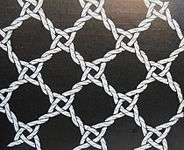Bobbin lace ground
Bobbin lace ground is the regular small mesh filling the open spaces of continuous bobbin lace. Other names for bobbin lace ground are net or réseau (French for network). The precise course of the threads and the resultant shape of the ground are an important diagnostic feature in lace identification, as different lace styles use different grounds.[1]
Point ground
Point ground is also known as fond simple or simple ground, fond clair, Lille, point, net ground or Bucks Point ground.
Grid angle: 52°-70°, usually 60°, never 45° [2]:146
It is a simple hexagonal mesh. Each stitch uses a pair of threads on each side. Some threads travel diagonally, and some move to left, then back to right, from stitch to stitch.
This ground is used in Bucks Point, Lille, Chantilly, and blonde lace.[1]
 Bucks Point ground
Bucks Point ground
Torchon ground
Torchon ground and double Torchon ground are used in Torchon lace.[1]
Grid angle: 45°
Each stitch uses a pair of threads on each side. In Torchon ground, the threads cross over. In double Torchon ground they cross and return to the same side they started.
 Torchon ground
Torchon ground a variation called Dieppe [3]
a variation called Dieppe [3] Double torchon ground
Double torchon ground
Mechlin ground
Mechlin is used in Mechlin lace.[1]
Grid angle: 45°
Each stitch uses a pair of threads on each side. It is similar to double Torchon ground, except there is no pin, and there may be more or less half stitches involved. Similar grounds are Brussels ground, Droschel, vrai reseau and bobbin mesh.
 Mechlin ground
Mechlin ground
Five Holes Ground
This ground is known as Rose ground , Point a la Vierge, fond de Mariage, fond de Flandres [4] is also known as cinq trous or five hole or virgin ground, or rose stitch. Not to be confused with the Dutch Rozengrond, what would be a literal translation but is used for the honeycomb ground.[5]
Grid angle: 45°
The appearance looks like a little rose, and there are four holes in the corners plus one in the centre. Each stitch uses two pairs of threads on each side. There are several different types of rose ground.
It is found in Antwerp and other Flanders lace, early Valenciennes, Torchon lace and yak lace.[1]
 Rose ground in Torchon lace, pins at the edges of each rectangle
Rose ground in Torchon lace, pins at the edges of each rectangle Flanders ground, same stitches, just a pin in the center of each rectangle
Flanders ground, same stitches, just a pin in the center of each rectangle Another form of Rose ground, applying the double Torchon ground
Another form of Rose ground, applying the double Torchon ground Rose ground sampler
Rose ground sampler
Point de Paris
Point de Paris is also called fond double or double ground, Kat stitch, wire, French, six-point star, star, star-pointed ground, hairpin stitch, fond chant.
The ground has hexagons and triangles, making a star-shaped mesh.
It is found in point de Paris, and in some Bucks point lace, Chantilly and Antwerp lace.[1]
 Point de Paris
Point de Paris
Valenciennes ground
Valenciennes ground is also known as square or diamond mesh.
Each stitch uses two pairs of threads on each side, which are plaited between the stitches. This gives the distinctive diamond look to the ground.
This ground is used in Valenciennes lace.[1]
 Valenciennes ground
Valenciennes ground
Snowflake ground
Snowflake ground is also known as fond de neige, partridge eye or oeil de perdix.
This ground is the characteristic ground of Binche lace, and is sometimes found in Mechlin lace.[1]
 ringed snowflake ground
ringed snowflake ground
Honeycomb ground
Honeycomb ground is also known as fond de mariage.
Grid angle: usually 60°
This ground is found in Bucks Point.[1] It is also used in Chantilly lace and Binche lace.[6]
 Honeycomb ground
Honeycomb ground
References
- Pat Earnshaw. A Dictionary of Lace. Shire Publications. p. 144. ISBN 0-85263-700-4.
- Nottingham, Pamela (1995). The technique of Bobbin Lace. London: Batsford. ISBN 0 486 29205 3.
- Dillmont, de, Therèse (1921). Les dentelles aux Fuseaux, 1st Serie (PDF). Mulhouse: Bibliothèque DMC. Archived from the original (PDF) on 2015-09-23. Retrieved 2014-12-26.
- "Archived copy". Archived from the original on 2016-12-20. Retrieved 2016-12-14.CS1 maint: archived copy as title (link)
- Antonides, Gerrie. Grondenlap in Torchon.
- Marion Powys. Lace and Lacemaking. Charles T. Branford Company.
